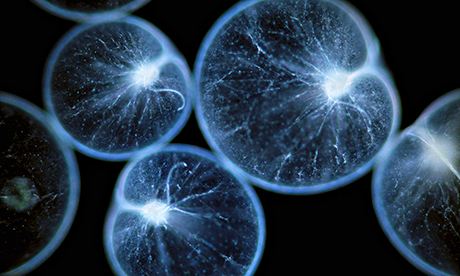
In July, a team of scientists organised by the American Museum of Natural History will dive 300 metres below the Atlantic Ocean's surface about 160km off the coast of New England. Among their goals: to find bioluminescent creatures - such as the dinoflagellates that make their own light, causing the ocean to glow - that they hope will offer clues for creating the next generation of medical imaging.
The right combination of molecules - a protein that can make light and another compound to serve as the light's fuel - may allow us to map brain activity to a new level of detail. This advance may some day give quadriplegics new ways to interact with the world.
Though it seems futuristic, the back story for this line of research began 50 years ago. In the early 1960s, a Japanese marine biologist named Osamu Shimomura isolated a protein from the crystal jellyfish. When blue light is shined on the creature, this protein absorbs it, changes its wavelength and emits a green light. It is called green fluorescent protein, or GFP.
"That single protein literally changed the course of biology," says Vincent Pieribone, a neurobiologist at Yale. It also won Shimomura a share of the 2008 Nobel prize in biochemistry.
Most of the structures inside a cell are clear, which makes observation a challenge. Biologists eventually realised that they could attach GFP to virtually anything inside a cell, then shine a blue light on it to observe its movements and activities. In the 1990s, geneticists spliced the jellyfish's GFP gene into mice and other lab creatures, essentially turning their bodies into living museums. They could express the protein in their muscle cells, brain cells or other organs. By shining the right wavelength of light on to the animal, scientists could watch cancer spread or the immune system fight viruses.
For all its incredible applications, GFP has a major shortcoming: it needs an external light source. Blue light doesn't penetrate far, so we have trouble seeing deep into a complex organ. The inner workings of a mammalian brain, for example, are nearly impossible to observe using GFP, because it's too difficult to shine a light in there. In addition, haemoglobin, the oxygen-carrying protein in red blood cells, absorbs blue light differently depending on how much oxygen is present. This complicates the delivery of the blue light and the detection of green light from the cells. We need a method that enables us to work in darkness. If only there were creatures that emitted their own light.
You've probably seen one such creature in your own backyard, as night begins to fall in summer: the firefly. Lampyridae is, indeed, one of the few terrestrial creatures capable of producing its own light. As with fluorescent animals, bioluminescent creatures rely on a protein to shine their lights, so it's appealing to think that we could just extract the protein and attach it to proteins in mammalian cells. But there's an extra piece involved in bioluminescence that makes it a more complex process.
"The chemical reaction has two parts," Pieribone explains. "The protein is the engine. But it requires fuel - a small molecule that is produced by the animal and burned."
It's easy enough to insert the firefly's protein into other animal cells, or even to force other animals to manufacture it, but researchers haven't been able to get the fuel source in place. None of the fuel molecules used in known bioluminescent creatures can be produced in the cells of a mouse, dog or primate. What we need instead is a bioluminescent creature that relies on a fuel that's already present in mammalian cells. Glucose and adenosine triphosphate, for example, are high-energy molecules in ample supply in mammals.
The medical applications of a bioluminescent compound are potentially enormous. With them we may see, for example, how electrical impulses translate into muscular actions. Using a machine that can interface with those signals, a quadriplegic could merely think about picking up a fork, and a robotic arm would execute the command.
That's where July's deep-diving expedition comes in. A team of scientists will each don diving gear called an exosuit, which looks something like a costume piece from a superhero movie. Its pressure-resistant body and finely tuned joints permit a person to descend to 300 metres and still move smoothly. It is equipped with thrusters on the feet and specialised hand attachments that can grasp interesting objects or collect specimens with a vacuum device. Researchers on the surface can see what the diver sees through the four cameras mounted on the suit.
Do they have any reason to believe that they'll find a glucose-powered bioluminescent creature lurking off the Atlantic coast? Not exactly, says Pieribone, but that's exploration.
"It's a bit of a fishing expedition, but we have our hooks in a really rich pool," he notes. "Let's get into a genetically rich environment and observe with our eyes."
This article appeared in Guardian Weekly, which incorporates material from the Washington Post



Reader Comments
to our Newsletter